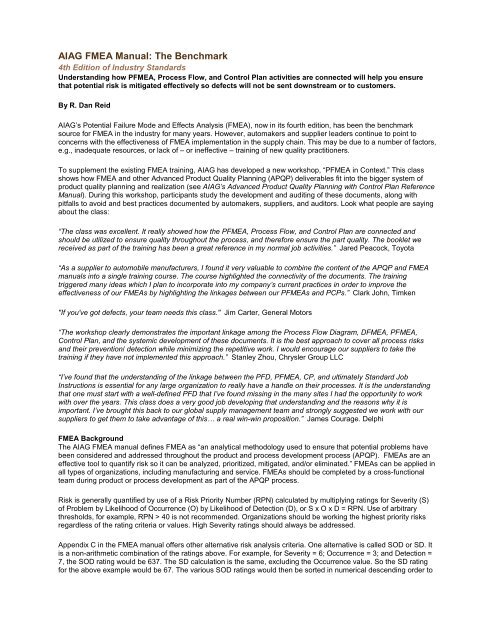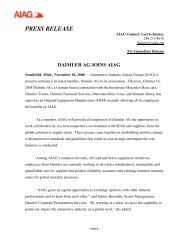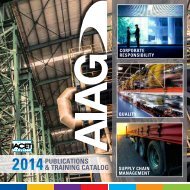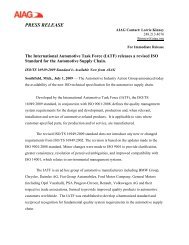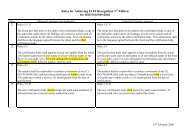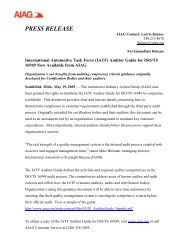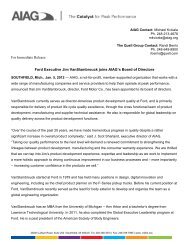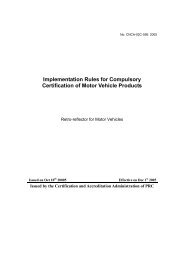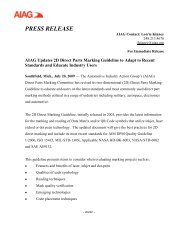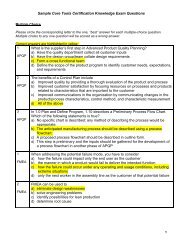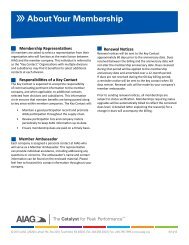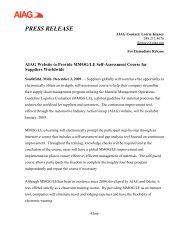AIAG FMEA Manual: The Benchmark - Automotive Industry Action ...
AIAG FMEA Manual: The Benchmark - Automotive Industry Action ...
AIAG FMEA Manual: The Benchmark - Automotive Industry Action ...
You also want an ePaper? Increase the reach of your titles
YUMPU automatically turns print PDFs into web optimized ePapers that Google loves.
<strong>AIAG</strong> <strong>FMEA</strong> <strong>Manual</strong>: <strong>The</strong> <strong>Benchmark</strong><br />
4th Edition of <strong>Industry</strong> Standards<br />
Understanding how P<strong>FMEA</strong>, Process Flow, and Control Plan activities are connected will help you ensure<br />
that potential risk is mitigated effectively so defects will not be sent downstream or to customers.<br />
By R. Dan Reid<br />
<strong>AIAG</strong>’s Potential Failure Mode and Effects Analysis (<strong>FMEA</strong>), now in its fourth edition, has been the benchmark<br />
source for <strong>FMEA</strong> in the industry for many years. However, automakers and supplier leaders continue to point to<br />
concerns with the effectiveness of <strong>FMEA</strong> implementation in the supply chain. This may be due to a number of factors,<br />
e.g., inadequate resources, or lack of – or ineffective – training of new quality practitioners.<br />
To supplement the existing <strong>FMEA</strong> training, <strong>AIAG</strong> has developed a new workshop, “P<strong>FMEA</strong> in Context.” This class<br />
shows how <strong>FMEA</strong> and other Advanced Product Quality Planning (APQP) deliverables fit into the bigger system of<br />
product quality planning and realization (see <strong>AIAG</strong>’s Advanced Product Quality Planning with Control Plan Reference<br />
<strong>Manual</strong>). During this workshop, participants study the development and auditing of these documents, along with<br />
pitfalls to avoid and best practices documented by automakers, suppliers, and auditors. Look what people are saying<br />
about the class:<br />
“<strong>The</strong> class was excellent. It really showed how the P<strong>FMEA</strong>, Process Flow, and Control Plan are connected and<br />
should be utilized to ensure quality throughout the process, and therefore ensure the part quality. <strong>The</strong> booklet we<br />
received as part of the training has been a great reference in my normal job activities.” Jared Peacock, Toyota<br />
“As a supplier to automobile manufacturers, I found it very valuable to combine the content of the APQP and <strong>FMEA</strong><br />
manuals into a single training course. <strong>The</strong> course highlighted the connectivity of the documents. <strong>The</strong> training<br />
triggered many ideas which I plan to incorporate into my company’s current practices in order to improve the<br />
effectiveness of our <strong>FMEA</strong>s by highlighting the linkages between our P<strong>FMEA</strong>s and PCPs.” Clark John, Timken<br />
"If you've got defects, your team needs this class." Jim Carter, General Motors<br />
“<strong>The</strong> workshop clearly demonstrates the important linkage among the Process Flow Diagram, D<strong>FMEA</strong>, P<strong>FMEA</strong>,<br />
Control Plan, and the systemic development of these documents. It is the best approach to cover all process risks<br />
and their prevention/ detection while minimizing the repetitive work. I would encourage our suppliers to take the<br />
training if they have not implemented this approach.” Stanley Zhou, Chrysler Group LLC<br />
“I’ve found that the understanding of the linkage between the PFD, P<strong>FMEA</strong>, CP, and ultimately Standard Job<br />
Instructions is essential for any large organization to really have a handle on their processes. It is the understanding<br />
that one must start with a well-defined PFD that I’ve found missing in the many sites I had the opportunity to work<br />
with over the years. This class does a very good job developing that understanding and the reasons why it is<br />
important. I’ve brought this back to our global supply management team and strongly suggested we work with our<br />
suppliers to get them to take advantage of this… a real win-win proposition.” James Courage. Delphi<br />
<strong>FMEA</strong> Background<br />
<strong>The</strong> <strong>AIAG</strong> <strong>FMEA</strong> manual defines <strong>FMEA</strong> as “an analytical methodology used to ensure that potential problems have<br />
been considered and addressed throughout the product and process development process (APQP). <strong>FMEA</strong>s are an<br />
effective tool to quantify risk so it can be analyzed, prioritized, mitigated, and/or eliminated.” <strong>FMEA</strong>s can be applied in<br />
all types of organizations, including manufacturing and service. <strong>FMEA</strong>s should be completed by a cross-functional<br />
team during product or process development as part of the APQP process.<br />
Risk is generally quantified by use of a Risk Priority Number (RPN) calculated by multiplying ratings for Severity (S)<br />
of Problem by Likelihood of Occurrence (O) by Likelihood of Detection (D), or S x O x D = RPN. Use of arbitrary<br />
thresholds, for example, RPN > 40 is not recommended. Organizations should be working the highest priority risks<br />
regardless of the rating criteria or values. High Severity ratings should always be addressed.<br />
Appendix C in the <strong>FMEA</strong> manual offers other alternative risk analysis criteria. One alternative is called SOD or SD. It<br />
is a non-arithmetic combination of the ratings above. For example, for Severity = 6; Occurrence = 3; and Detection =<br />
7, the SOD rating would be 637. <strong>The</strong> SD calculation is the same, excluding the Occurrence value. So the SD rating<br />
for the above example would be 67. <strong>The</strong> various SOD ratings would then be sorted in numerical descending order to
get the highest Severity scenarios at the top of the list.<br />
Appendix D lists some alternative techniques to <strong>FMEA</strong> for analyzing risk. <strong>The</strong>se include Failure Mode, Effect and<br />
Criticality Analysis (FMECA); Design Review Based on Failure Modes (DRBFM); and Fault Tree Analysis (FTA).<br />
Examples of some these are provided in the Appendix.<br />
<strong>FMEA</strong> Scope<br />
<strong>The</strong> <strong>FMEA</strong> <strong>Manual</strong> indicates that the <strong>FMEA</strong> scope “establishes the boundary of the <strong>FMEA</strong> analysis.” <strong>The</strong> scope can<br />
be system, subsystem, or component. A system consists of many subsystems, which consist of many components.<br />
<strong>The</strong> linkages and interactions among parts within the scope, as well as with other subsystems or systems also have<br />
to be addressed. <strong>The</strong> <strong>FMEA</strong> <strong>Manual</strong> lists a number of tools that can help define the appropriate scope, which should<br />
dictate the appropriate team membership. <strong>The</strong>se include: block diagrams, process flow charts, schematics, and bills<br />
of material.<br />
Other <strong>FMEA</strong> <strong>Manual</strong> Guidance<br />
<strong>The</strong> <strong>FMEA</strong> <strong>Manual</strong> also contains an Index and list of helpful references. It also adds numerous examples and<br />
diagrams to provide helpful guidance. <strong>The</strong>re is a section on linkage of <strong>FMEA</strong>s to other documents, including the block<br />
diagram and the Design Verification Plan and Report (DVP&R).<br />
<strong>FMEA</strong> “Acceptance Criteria”<br />
What constitutes an acceptable <strong>FMEA</strong> A good <strong>FMEA</strong> should:<br />
• Be completed across to the right side, which is the area for re-computing Risk after initial efforts have been<br />
taken to reduce the initial high risk rating, e.g. RPN;<br />
• List multiple effects for each mode and multiple causes for each effect. Generally there is not a 1:1<br />
relationship, as any given failure mode could have many effects;<br />
• List actions taken on high severity and high RPN, or other risk ratings, aimed at preventing the occurrence of<br />
a potential failure. Responsibility for the actions taken should be assigned and tracked to completion;<br />
• Include efforts to error-proof the design and/or process [see <strong>AIAG</strong>’s “Guideline to Effective Error-Proofing”<br />
(CQI-18)];<br />
• Ensure that measurement uncertainty is known and acceptable for applicable metrics;<br />
• Identify characteristics which should be designated as “special” or critical on the Control Plan so actions can<br />
be planned and implemented to mitigate the effects of the potential failure;<br />
• Carefully consider all the risk, e.g. safety, quality, equipment, and resource, as well as efficiency of methods<br />
used, actions taken, and contingency planning;<br />
• Consider the major types of design failures: materials, processes, costs; OR;<br />
• Consider the major types of process failures: too much, too little, missing, or wrong.<br />
Tying It Together<br />
Once the characteristics that need to be handled with extra care are identified in the <strong>FMEA</strong> and Control Plan, this<br />
information should be used to develop understandable Work Instructions for manufacturing, assembly, and<br />
verification activities to ensure that potential risk is mitigated effectively and so defects will not be sent downstream or<br />
to customers. Where risk is still significant as identified on the <strong>FMEA</strong>, additional verification activities may need to be<br />
implemented from the original plan.<br />
<strong>FMEA</strong> is a “living” document. When problems arise that were not previously identified, the <strong>FMEA</strong> and Control Plan<br />
should be revisited to include provisions to prevent recurrence. <strong>The</strong>se actions should be deployed as preventive<br />
actions for other applicable processes. <strong>The</strong>se activities require resource allocation from top management to provide<br />
practitioners with the time needed to complete these important activities.<br />
R. Dan Reid, <strong>AIAG</strong> program manager - quality, is best known as an author of QS-9000, ISO Technical Specification<br />
(TS) 16949, ISO 9001:2000, the first ISO International Workshop Agreement (IWA 1), and its replacement, <strong>AIAG</strong>’s<br />
Business Operating Systems for Healthcare Organizations (HF-2).<br />
For additional information on this topic, please contact the <strong>AIAG</strong> Program Manager Dan Reid, dreid@aiag.org.


